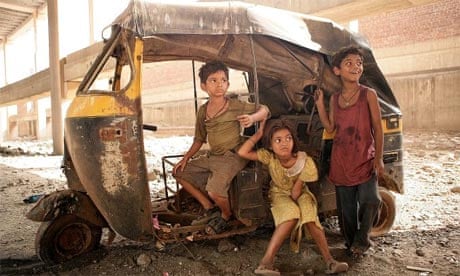A few weeks ago, Joss Whedon scored all the smart cultural points by taking us on an abridged world tour of horror in The Cabin in the Woods. But he seemed to trip up after putting superherodom on long-haul in Avengers Assemble – the Kolkata slum scenes (where Black Widow finds Bruce Banner on an indefinite gap year) were criticised by Indian actors for dealing in stereotypes and fixating on poverty in the country. "There are two scenes about India, and they only show slums," the Bengali star Rituparna Sengupta told the Hindustan Times. "It could have been done in better taste."
The Brits love carping about the Big-Ben-and-double-decker-bus shorthand that used to get rolled out in Hollywood films, so India can be (sort of) flattered that it now has its own equivalent. Avengers Assemble also had scenes in Stuttgart and New York City, subject to the same laws of cheesy popcorn-precis: like the history-ventriloquising Jewish pensioner who won't bow down to Loki in Germany. That's just the way pop culture works, in moron-proof nuggets – and India is firmly on its map now.
Slumdog Millionaire has set the mould for portrayals of the country and its people in the global mainstream, for good or for ill. The audience I was with during a screening of last year's comedy 30 Minutes or Less collectively gasped when Danny McBride's villain addressed an Indian-American character as "slumdog".
But the slum-portrayal issue is something separate to that of pop culture's need for stereotypes, and it's interesting that it has arisen again. The first time, for Slumdog Millionaire, the accusations seemed more serious: slum life was the subject of the entire film, and it was partly the slum-dwellers themselves who objected – to the use of "dog" in the title, which didn't seem to have any plucky associations at all in Hindi.
Amitabh Bachchan, the actor for whose autograph the young Jamal will go to any lengths in the film, also wrote an ambivalent blogpost that was widely picked up around the world: "If SM projects India as Third World dirty underbelly developing nation and causes pain and disgust among nationalists and patriots, let it be known that a murky underbelly exists and thrives even in the most developed nations."
That's too true. But films such as Slumdog Millionaire and Avengers Assemble seem to have touched an exposed nerve in India like nowhere else. Perhaps it's because pride is running high in a newly assertive country, and these are films made by outsiders; there have been Bollywood films set in shantytowns before, such as 1981's Chakra, 1988's Salaam Bombay!, and 1991's Dharavi, and they didn't attract the same controversy.
It's not as if there's been a recent shortage of "underbelly"-set offerings from fellow developing regions either, especially Latin America: City of God, Elite Squad, Secuestro Express, Sin Nombre, Amores Perros. But there's little outcry surrounding them. Their reception seems dictated by the same fetishising of sweat-slick ghetto life that has trickled down from North America; in some cases, the films themselves glamourised the grime.
That doesn't seem likely to happen in India. The reasons have to be cultural. I don't see any valuing of poverty there as a source of authenticity, or even aesthetic beauty; films like Fish Tank or Ratcatcher, excellent though they are, are definitely western in that sense. India is only just developing an indie-film circuit that might choose to wield the camera in that ethereal spirit.
Resistance to depicting slums in India is, I think, to do with the deeper expectations audiences bring to the cinema. A lot of Bollywood film is still anchored in unabashedly heroic narrative that draws its power from older mythological forms that, ultimately, have little patience for life at the demotic end: last year's thriller Singham, for example, gave full licence to its police hero cudgelling the local lowlife into line. There was no apology for it, as there would be in a Hollywood film (Harry Callahan does the same things as Singham, but he's definitely dirty in the eyes of his film), because that kind of compromising social and psychological realism don't fit easily into the classically heroic template that still governs popular Indian film-making. Any arguments about poverty being the No 1 cause of crime would have the burly Mr Singham reaching for his daystick. In real life, he'd probably be one of the people who thinks slums are too unseemly a part of Indian life to spend serious time on.
At least the sniping over Slumdog Millionaire and Avengers Assemble shows there's a lively conflict of opinions within India. I don't agree with those who cry poverty porn, and I believe it's important to put the more disturbing sides of the country on show. But I think it's healthy that the same critics don't buy wholesale into the ghetto-gangster bluster that's such a big part of modern urban mythology across the world, and which is really capitalism selling its own most violent urges back to those damaged the most by them. There's space between the two; in my eyes, Slumdog Millionaire found it.

Comments (…)
Sign in or create your Guardian account to join the discussion